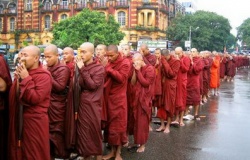Renunciation and Deliverance
The key move that charactrizes the act of becoming a monk is renunciation, going forth from the household life into homelessness. Homelessness is not absolutely essential for this work, true renunciation is an inner act, not a mere outer one. But the homeless life provides the most suitable outer conditions for practising true renunciation. But anyone who has correctly grasped the drift of the Dhamma will see that the path of renunciation follows from it with complete naturalness. The Buddha teaches that life in the world is inseparably connected with dukkha, with suffering and unsatisfactoriness, leading us again and again into the round of birth and death.
The reason we remain bound to the wheel of becoming is because of our attachment to it. To gain release from the round we have to extinguish our craving. That is the highest renunciation, the inner act of renunciation. But to win that attainment we generally must begin with relatively easy acts of renunciation, and as these gather force they eventually lead us to a point where we no longer are attracted to the pleasures of the world. When this happens, we become ready to leave behind the household life, to enter upon homeless state in order to devote ourselves fully to the task of removing the inner subtle clinging of the mind.
If a person finds himself unsuitable for monastic life he is free at any time to leave the robes and return to lay life without any kind of religious blame attached to himself.
